
Traders are familiar with the situation when an order closes and the price continues to grow and increase profits. However, it is already impossible to get it. The only thing left is to watch how many points it will pass in the profitable direction.
Those who use the Trailing Stops in trading know what is trading. It is best used when the market allows you to take more profit than was calculated and close the transaction with the maximum possible profits. In this case, you can manage the risks, which reduces potential losses.
Professional traders have long used this tool. It helps to cope with the strongest trends appearing from time to time.
What can be better than an assistant, which does not trigger at a certain level, but keeps moving after the increasing profits? No extra effort on your part is required.
It sounds like magic, but it is a kind of smart software, which makes trading even more effective.
Understanding trailing stop
A trailing stop is a trading tool that allows you to maximize all possible profits as well as minimize potential losses. It refers to variants of the moving stop loss order.
From a technical point of view, it goes either in the same direction as the growth of the asset if we are talking about long positions. When a short position is opened, it falls along with the price. The characteristic feature is that it moves along with market quotes.
Thus, a trailing stop order is used for the following:
- When the price rises, a trailing stop order begins to follow it until it reaches the maximum possible level before the reversal.
- When the trend changes, there is an automatic closing of the transaction, which makes the losses smaller.
| Trailing stop sets a stop loss order to automatically follow the price to maximize profits and minimize losses. |
The main purpose of this order is to protect against losses in the event of a market reversal in the opposite direction. It works in automatic mode but only when the trading platform is open.
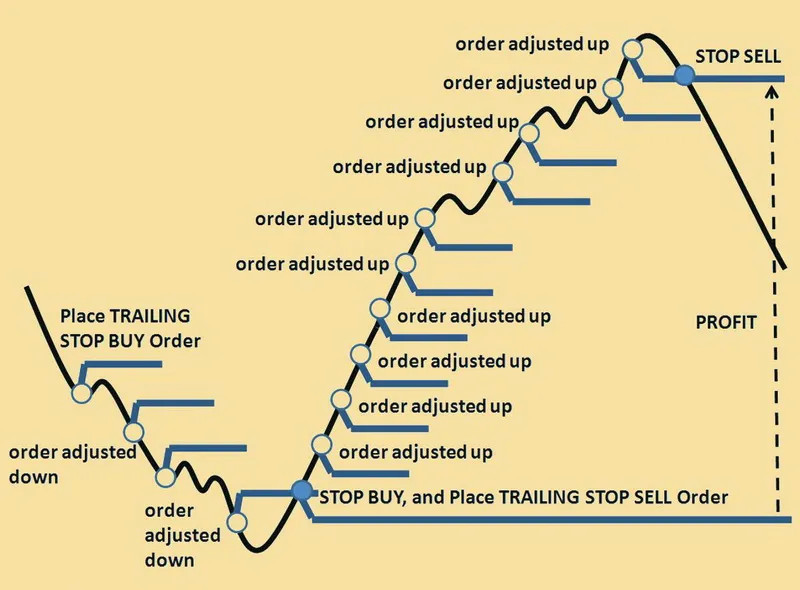
The tool corrects all actions itself, the trader does not need to manage it. It is enough to monitor the market carefully and timely activate the tool.
It is better to use this tool when the market starts to show a strong price momentum.
How trailing stop is used
The order starts working after you open a new position in the direction of the trend. The conditional distance from the current price of the asset to the expected level of Trailing Stop, which is measured in points, is determined.
For example, a buy order is opened and the price is 1.250. The "floating" stop order is placed 50 points lower at the level of 1.200.
When the set price threshold is overcome, it will move upwards, and the trailing stop will start chasing it. At the same time, the difference of 50 points will be maintained.
This will continue until a reversal occurs, after which the trade will automatically close. If the price goes down, the order will not move.
As for short positions, everything will happen similarly, only on the contrary.
Two ways to use trailing stop:
- Automatic. The tool follows the price at a predetermined distance. It is based on arbitrary levels that have no real counterparts in the market.
- Manual. Traders determine the necessary distance between levels based on their strategy.
Differences between stop loss and trailing stop
These well-known tools are different although many people say that trailing stop is a kind of stop-loss order. However, there is a big difference between them:
A "floating" tool is needed to provide a trader with the maximum possible profit. This happens when the market is moving up. A stop loss is a loss limiter. It is needed when the price is moving against the direction of a trader’s position. |
In addition, a trailing stop order is always moving, while a stop loss order remains at the level where it was placed.
The first is always active when the market starts to move. The second is activated only when the price reaches a certain level.
Pros of trailing stop
• Increasing profits and reducing losses
The tool provides traders with the maximum profit. However, it can also be used to reduce potential losses during trading.
Investors often call it a "safety belt" in trading. This is because it quickly reverses a position if a sharp price reversal occurs.
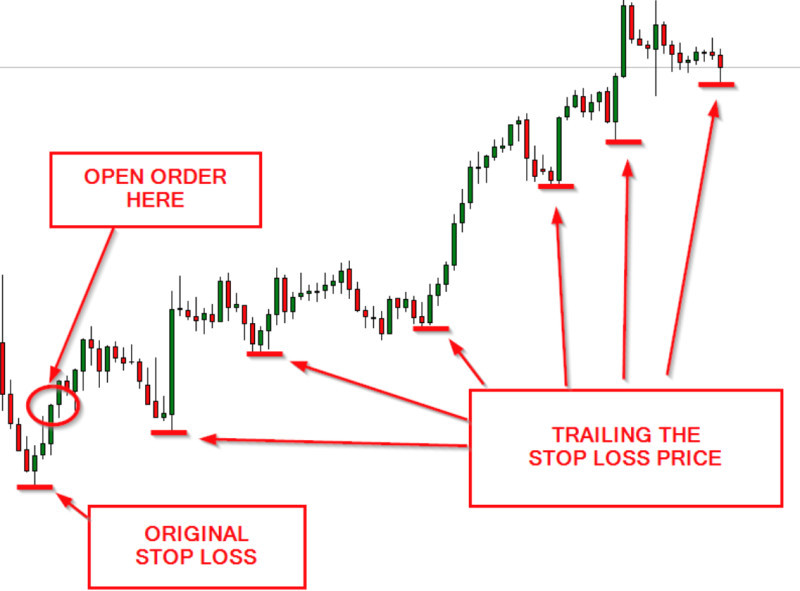
Important. When the tool works automatically, a trade is closed much faster than in manual mode. It is very convenient to stay in the black even when the direction has already changed.
• High volatility
All changes occur in real-time, i.e. there is no delay from the set position. This makes it an indispensable tool when the market is highly volatile.
Losses are practically eliminated and the reaction to the growth will not keep you waiting. This is the reason why scalpers like to use it in trading.
• Significant time saving
This tool saves a trader's time. Traders do not need to constantly monitor market moves in front of their PC. There is no need to keep track of it and move a stop-loss order since everything happens automatically.
This feature is crucial when trading several assets at the same time. Manually setting stop-loss orders for each position would take a lot of time and effort.
In addition, a quick reaction when the market moves to higher volatility or liquidity is extremely important. Quick decision-making and reaction are critical. Sometimes, a fraction of a second can determine the outcome of a trade.
• Combination with all trading styles
The tool has been successfully used in almost all trading strategies. It has been used successfully not only in scalping but also in day trading and pair trading.
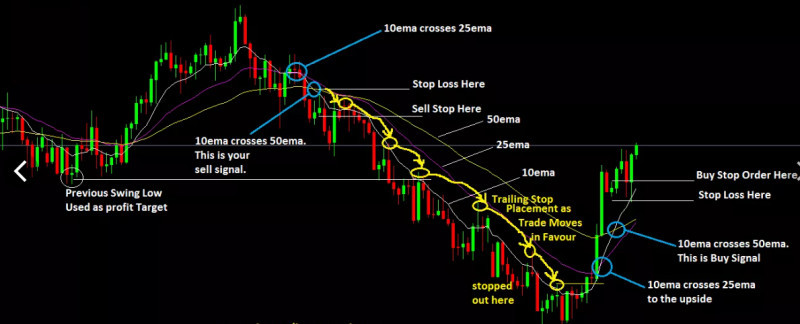
It is often used when testing new strategies when the basic nuances have not yet been worked out. All this is thanks to the fact that the risk of potential losses is significantly reduced.
It is easier to control open orders and therefore the psychological pressure on the trader is lower. This makes trading more comfortable and confident.
Cons of trailing stop
| No. | Cons | Description |
| 1. | Need to stay connected to trading servers | It requires constant contact between the trading platform and the servers of the intermediary, i.e. the brokerage firm. Thus, a lot of energy is spent on keeping the software open. In addition, in some situations, it is necessary to have additional programs running all the time, such as VPS. This is the only way to make the tool work without errors. Important! After closing the trading platform, TS remains at the level it reached. It is impossible to get rid of this disadvantage because it belongs to the category of technical features. |
| 2. | Poorly matched to overly volatile markets | The indicator does an excellent job when it comes to trend trading or trading on reversals. However, it can behave incorrectly in highly volatile markets with too large a price gap. It is a wide range that pushes the indicator to close the position prematurely, after which there may be another breakout. Thus, potential profits will be missed as it happens when using an ordinary stop-loss order. Ways to overcome this disadvantage: 1. Increase the distance of the "floating" stop. Then short-term corrections will not lead to the premature closing of the order. At the same time, the risk of losses will increase. 2. Turning off the indicator in situations when the market volatility begins to increase and the range widens. For such periods, it is better to use a stop-loss order. |
TS is perfect for some market situations, but it should be used wisely. It is better to test your strategy on a demo account first.
How trailing stop works
The tool "chases" the value in real-time. It stops when the market reverses and changes direction. This defines the main essence of its use, which boils down to several principles:
1. Long position.
TS moves up with the price, gaining momentum with the market. The turning point is a reversal. The indicator stops and then closes the order after reaching the set level.
2. Short position.
TS moves downwards following the price. The stop-loss is triggered when the price starts to rise. The order is automatically closed when the preselected level is reached.
Important: A trailing stop closes positions only when the preselected level is reached. This keeps the transaction in a profitable area.
Examples of using trailing stops in live trading
| Long position | Short position |
A long position was opened at the level of 1.12400. A trailing stop is placed 40 points below the entry price at the level of 1.1200. Two scenarios:
| A short position is opened at the level of 1.12800. The trailing stop is set 40 points above the entry price at 1.13200. Two scenarios:
|
It is best to determine the strategic TS levels based on support and resistance levels.
Use TS in the following situations:
1. The beginning of the period of volatility, when there is a rapid movement of prices and the margin cannot be determined.
The TS allows you to get the maximum benefit and close the trade in time when the trend reversal occurs.
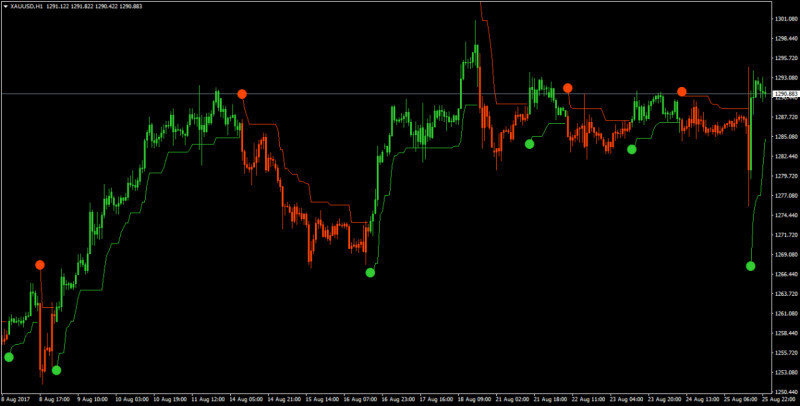
2. Trading on economic news.
Every trader knows that some assets show a wide movement only during periods of important economic news. This is the moment of volatility growth, which is suitable for TS.
3. Scalping strategies.
For some scalping strategies, trailing stops are very suitable as they help to prevent losses.
Faults when using trailing stop:
It would be wrong to think of TS as a universal helper. It works well only under certain conditions. Sometimes its use is inappropriate, causing more problems than benefits.
The most common mistakes when using TS:
- TS works only when the trading platform is open. This is often forgotten, so after connecting the platform, you need to reconfigure the tool.
- Wrong calculation of the TS level. This can slash the potential income if the size is too small. When setting the trailing stop distance, it is necessary to take into account your strategy.
- Using the tool without preliminary testing on a demo account, as well as on historical data.
- Using the indicator as an emergency tool for a strategy that is already moving in an unprofitable direction.
TS cannot completely solve all problems. It can only make your strategy more efficient and easy to implement.
How to install trailing stop
Usually, installing TS on MetaTrader 4 or MetaTrader 5 trading platforms does not cause any particular difficulties. There are several ways to do it.
Three ways to install TS:
1. Trailing Stop in MetaTrader mini
It is considered to be the fastest and most convenient way of connection. To activate it, you need to find the field with the name of the indicator in the Mini Terminal's taskbar. After filling in the basic parameters, the tool will be activated and you will be able to use it.
Adjustable parameters:
- Fixed risk
- Percentage of funds
- Balance as a percentage
Once activated, the tool will operate in automatic mode.
2. Standard connection based on MetaTrader trading terminal
To connect the trailing stop, you need to open an order first. Then you can install the indicator.
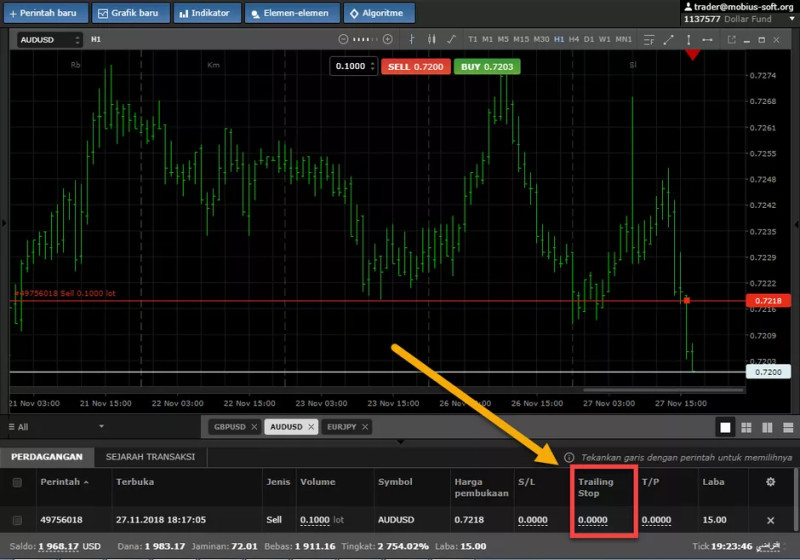
In this method, you should find an open order at the bottom and right-click it. After that, a window will appear in which it will be necessary to select TS and set parameters.
3. Smart Lines function in MetaTrader
SL are special lines drawn on the chart. They allow you to set not only a "floating" stop-loss indicator but also a "floating" take-profit.
To place a trailing stop-loss on an existing uptrend line, press and hold the Alt key and click the left mouse button. A menu will appear where you can customize the indicator.
You can use any of the ways to install TS. It will work effectively and according to the specific tasks.
It is important to remember that only one instrument can be installed on any order at a time. Therefore, each new deal requires a new connection of the indicator. Its automatic transfer from one transaction to another is impossible.
At what distance to set trailing stop
The question of distance can be considered perhaps the most important in terms of the proper functioning of the indicator. So far, there are three popular methods.
Methods of distance determination for TS:
1. Measuring the distance based on the correlation with the ATS indicator
Many market participants are accustomed to using some technical analysis indicators for trading. One of the most popular is the so-called Average True Range.
Its main function is to determine the level of volatility of the selected asset in the market. The trailing stop can be well combined with such functionality, both tools complement each other.
There are several ways to determine the distance:
• When scalping, you can immediately specify the number of pips that the ATR will give. Usually, the distance will be quite small to take advantage of short-term trading.
Remember that it is based on bursts of volatility that occur frequently. There is a higher risk of closing a trade prematurely.
• In intraday or pair trading you should multiply the number of ATR points by two. In this case, a good result will only be possible if you can survive significant market pullbacks.
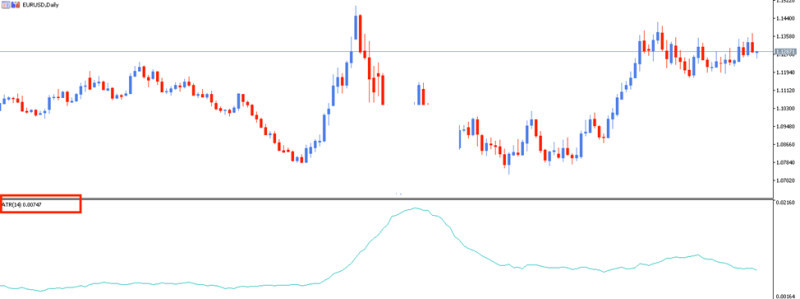
Note: Multiplying by two is the standard formula, but no one is forbidding traders to derive another way by their practical measurements. For example, multiply by three or even more, depending on the chosen strategy and asset.
2. Measuring the distance according to the Fibonacci levels
It is characteristic of trading on reversals. Before setting the TS, it is necessary to mark the corresponding Fibonacci levels on the chart. Then there are two ways to determine the trailing position:
• When pullbacks appear on the chart, wait for the trading signal. Then measure the distance between the zero Fibonacci level and the price of the asset. This will be the position distance for the floating stop.
• The points are determined by measuring the distance between the zero Fibonacci level and the first recovery marker. These measurements are used as the distance.
3. Distance measurement based on price action
This method is perfect for traders who are accustomed to focusing their work on price movement and using the PA strategy.
The distance estimation for the trailing stop is based on which trade is opened:
• To buy - the distance between the prices of the last support level is calculated.
• To sell - the distance between the last resistance levels is calculated.
Regardless of the method of setting the trailing stop, it is better to test the tool on a demo account. This will allow you to configure the tool to work more accurately and avoid serious mistakes that can lead to losses.
Conclusion
It is becoming more and more popular among traders to use such trading tools as trailing stops. However, only very experienced traders who know how to work with it will decide to use it.
Sometimes the behavior of the tool is different from the expectations in advance. This is due to mistakes made when using it.
However, the right approach can significantly increase the potential investor's profit. It can also compensate for the risks associated with sudden price reversals. Correct actions help reduce potential losses.
The tool is an excellent assistant when there is no possibility to control the whole process of trading on the market. The only thing you have to keep in mind is that the trading platform should be open at all times.
TS is practically universal due to the large number of variants of its use in various strategies. However, it is most suitable for conservative or moderately aggressive strategies. The risk is either low or medium.
Despite the seeming simplicity of using it, it is better to test the tool on demo accounts to avoid making fatal mistakes and to master this skill.
You may also like:








 Back to articles
Back to articles

